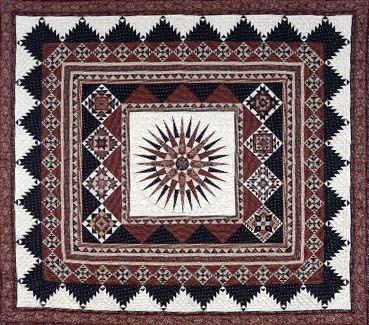 | ||
Quilts of the Underground Railroad were believed by some, and discounted by historians, to be used to communicate information to African American slaves about how to escape to freedom via the Underground Railroad.
Contents
Books that hypothesize quilt use
In Stitched from the Soul (1990), Gladys-Marie Fry asserted that quilts were used to communicate safe houses and other information about the Underground Railroad, which was a network through the United States and into Canada of "conductors", meeting places, and safe houses for the passage of African Americans out of slavery. The theory that quilts and songs were used to communicate information about the Underground Railroad, though is disputed among historians. Even so, escaping slavery was generally an act of "complex, sophisticated and covert systems of planning".
In the 1999 book Hidden in Plain View, written by Raymond Dobard, Jr., an art historian, and Jacqueline Tobin, a college instructor in Colorado explores how quilts were used to communicate information about the Underground Railroad. The idea for the book came from Ozella McDaniel Williams who told Tobin that her family had passed down a story for generations about how patterns like wagon wheels, log cabins, and wrenches were used in quilts to navigate the Underground Railroad. Williams stated that the quilts had ten squares, each with a message about how to successfully escape. It started with a monkey wrench, that meant to gather up necessary supplies and tools, and ended with a star, which meant to head north. The book claims that there was a quilt code that conveyed messages in counted knots and quilt block shapes, colors and names. In a 2007 Time magazine article, Tobin stated: "It's frustrating to be attacked and not allowed to celebrate this amazing oral story of one family's experience. Whether or not it's completely valid, I have no idea, but it makes sense with the amount of research we did." Dobard said, "I would say there has been a great deal of misunderstanding about the code. In the book Jackie and I set out to say it was a set of directives. It was a beginning, not an end-all, to stir people to think and share those stories." He called the book "informed conjecture, as opposed to a well-documented book with a "wealth of evidence".
Even though the book tells the story from the perspective of one family, folk art expert Maud Wahlman believes that it is possible that the hypothesis is true. "There’s a tradition in Africa where coding things is controlled by secret societies. If you want to learn the deeper meaning of symbols, then you need to show worthiness of knowing these deeper meanings by not telling anyone," she said. Wahlman wrote the forward for Hidden in Plain View.
Response
Giles Wright, an Underground Railroad expert, asserts that the book is based upon folklore that is unsubstantiated by other sources. He also said that there are no memoirs, diaries, or Works Progress Administration interviews conducted in the 1930s of ex-slaves that mention quilting codes. Quilt historians Kris Driessen, Barbara Brackman, and Kimberly Wulfert do not believe the theory that quilts were used to communicate messages about the Underground Railroad.
Controversy in the hypothesis became more intense in 2007 when plans for a sculpture of Frederick Douglass at a corner of Central Park called for an arrangement of granite square was to be placed in the ground to symbolize the manner in which slaves were aided along the Underground Railroad. Noted historians did not believe that the hypothesis was true and saw no connection between Douglass and this belief. Civil War historian David W. Blight, said "At some point the real stories of fugitive slave escape, as well as the much larger story of those slaves who never could escape, must take over as a teaching priority. It ought to be rooted in real and important aspects of his life and thought, not a piece of folklore largely invented in the 1990s which only reinforces a soft, happier version of the history of slavery that distracts us from facing harsher truths and a more compelling past." Fergus Bordewich, the author of Bound for Canaan: The Underground Railroad and the War for the Soul of America, calls it "fake history", based upon the mistaken premise that the Underground Railroad activities "were so secret that the truth is essentially unknowable". He says that most of the people who successfully escaped slavery were "enterprising and well informed."
Even so, there are museums, schools, and others who believe the story to be true. An education coordinator at the Plymouth Historical Museum in Michigan, Anna Lopez said to Time, "What I tell kids is, who writes history? Men do. Mostly white men. Then I ask, who made quilts? Women did, and a lot of black women made quilts and passed on their oral history. No one wrote down their history, so who knows?" John Reddick, who worked on the Douglass sculpture project for Central Park, states that it is paradoxical that historians require written evidence of slaves who were not allowed to read and write. He likens the coding of the quilts to the language in Swing Low, Sweet Chariot, in which slaves meant escaping but their masters thought was about dying.
